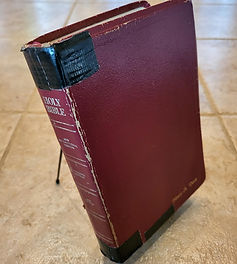Adding Narrative to Life
B E H I N D T H E B O O K
I became interested in the subject of life after death at a young age. Growing up in a household with a very violent and volatile father, the possibility of death was never far from my mind. And after the incident recounted in Gambling with Your Soul, I fully accepted that one day – which I expected to be during my childhood – my life was going to end. So, it was only natural for me to ask The Question: “What will happen to me when I die?” In a way, one could say that I started writing the book the next day. But of course, it would be many years before pen was put to paper.

Henry's childhood home in Memphis, TN.
One of the most difficult things to accomplish in writing the book was to stay objective. As a Christian, naturally, I first approached the topic through that religious lens. However, after several rewrites, it became clear that I had to broaden my lens and approach the subject from an unbiased, neutral, and completely objective perspective. The experience that allowed me to make the transition was a change in my professional career. In 2017, seven years after putting ink to paper, I joined the quality department in an aerospace company. Although I had held leadership positions in the aerospace industry for many years, that was the first time I had direct responsibility for the quality organization. As the organization most often charged with implementing root cause and corrective actions, quality professionals have developed a system – a Quality Management System (QMS), which allows them to be effective in this task. Part of the QMS is a method to confirm that corrective actions have been successful. It is called verification of corrective action (VCA). The process requires the review – or rather, verification – of objective evidence to prove/demonstrate that the actions taken have resolved the problem/issue. Using this logic, I asked myself, what objective evidence can be presented then verified to prove that we will experience the afterlife promised by any religion? And of course, there is none.

During my professional career, I held positions which required a significant amount of travel – allowing me to fulfill my corporate obligations and do research for the book. A win-win. Over a 20-year period, I did extensive traveling throughout the United States, visiting nearly all 50 states. As was/is my custom, I always travel with my bible. It's a great conversation starter. And since my objective was to learn about other faiths - rather than prove/argue that Christianity was right - people were enthusiastic about sharing their beliefs.
In addition to domestic travel, I circumnavigated the globe several times. Countries/territories I visited include The Bahamas, Brazil, Canada, China, Denmark, England, France, Germany, India, Ireland, Israel, Italy, Japan, Korea, Mexico, The Netherlands, Poland, Puerto Rico, Saint Martin, Saint Thomas – U.S. Virgin Islands, Singapore, Spain, Sweden, and Thailand. I also had meaningful conversations with individuals from many other countries including Armenia, Australia, Guana, Jamica, Morocco, Nigeria, Venezuela, Vietnam, Taiwan, and Togo.


Henry (second from the right) with business colleagues and city officials in Jinan, China.
To ensure the analysis did not show favoritism towards any religion, the manuscript was provided to individuals of various faiths including Atheism, Christianity, Islam, Judaism, Pantheism, and Sikhism. Then, for an extra measure of impartiality, the manuscript – which endured 17 rewrites – was read by individuals with no religious affiliation.
While the lion’s share of data was gathered from online sources, I also read many books. Notable among religious or spiritual books I read are Christian Yoga: The Mystical Journey From Jesus to Christ – Book 1: Initiation Into the History and Philosophy of Mystical Christianity, by Dr. Muata Abhaya Ashby; A Complete Comparison of the Four Gospels, by John D. Litteral; The Dead Sea Scrolls: A New Translation, by Michael Wise, Martin Abegg, Jr., and Edward Cook; The Holy Bible, New International Version, published by The Zondervan Corporation; The Holy Bible, New American Bible – Revised Edition, published exclusively for Saint Benedict Press by Good Will Publishers; Introduction to African Religion – Second Edition, by John S. Mbiti; The Long Discourses of the Budda: A Translation of the Digha Nikaya, by Maurice Walshe; Metu Neter – Volume 1: The Great Oracle of Tehuti and the Egyptian System of Spiritual Cultivation, by Ra Un Nefer Amen; The Nag Hammadi Scriptures: The International Edition, edited by Marvin Meyer; The Noble Qur'an, translated by Dr. Muhammad Taqi-ud-Din Al-Hilali and Dr. Muhammad Muhsin Khan; and Reaches of Heaven: A Story of the Baal Shem Tov, by Isaac Bashevis Singer.
Novels and nonfiction accounts I read that addressed – in whole or in part – the subject of life after death include The Complete Prophecies of Nostradamus, translated, edited, and interpreted by Henry C. Roberts, re-edited by Lee Roberts Amsterdam and Harvey Amsterdam, and updated by Robert Lawrence; Embraced by the Light, by Betty J. Eadie; Encyclopedia of Afterlife Beliefs and Phenomena, by James R. Lewis; How Different Religions View Death and Afterlife – Second Edition, edited by Christopher Jay Johnson, PhD and Marsha G. McGee, PhD; Life After Life, by Raymond A. Moody Jr., M.D.; Pascal’s Wager: The Man Who Played Dice with God, by James A. Connor; and The Tibetan Book of the Dead, composed by Padmasambhava, revealed by Terton Karma Lingpa, translated by Gyurme Dorje, and edited by Graham Coleman with Thupten Jinpa.

Henry preparing for takeoff to another destination.

Henry's bible, which accompanied him on every trip.



